COUPON – Save 30% off your entire order with code NAPLAB.
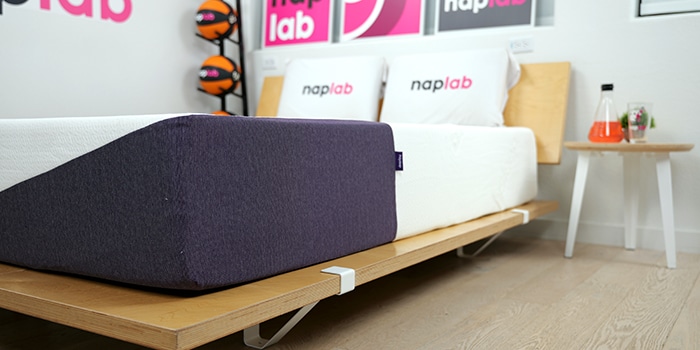
Best For
- Very fast material response time
- Slightly less motion transfer than average
- Priced 9% less than the average foam mattress, making it a nice budget pick
Considerations
- Low bounce contributes to lower sex performance
- Longer off-gassing (11 days) than average (7 days)
- Short 100-night trial period, 70 nights shorter than average
Our Verdict
The Polysleep Luna mattress is a 12″ foam mattress made of poly foam and support foam. Polysleep is calling this a memory foam mattress, but I don’t I agree with their assessment. Based on my testing of the wider mattress market, I would call this just a foam / poly foam mattress. It does not have a memory foam feel, in my view.
The Polysleep Luna is available in a single firmness level — medium-firm.
This mattress has minimal sinkage and low levels of bounce. It does not have a dramatic memory feel, hug, significant contour, or viscoelastic properties, all of which are attributes of memory foam. This isn’t good or bad, but if you are expecting a more notable memory foam feel, you could be disappointed with the experience.
In our performance tests, this mattress earned an overall score of 8.17, ranking the mattress in the bottom 22% of all mattresses tested to date.
The Polysleep Luna is C$963 for a queen-sized mattress, which is 9% lower than the average price for a foam mattress, saving sleepers around C$92. For sleepers on a tighter budget, the Luna can be a good option, but be prepared to give up some aspects of performance.
The Luna is available in both the US and Canada. To purchase in Canada use this link and for US shoppers use this link.
Type: Foam
Firmness: Medium-Firm (6)
Best For: All Sleeping Positions, All Body Weights
In This Review
Performance Tests | Firmness | Support & Sleeping Positions | Design | Materials | Comparisons | FAQs
Performance Tests
At NapLab, we put each mattress to the test.
We test 10 different factors that impact the performance, comfort, and feel of the mattress. We then take the results of those tests and compare them to every mattress we’ve tested to date.
Check out the full performance table below to see how this mattress ranks:
| Factor | Polysleep Luna | Average |
|---|---|---|
| Overall Score | 8.17 | 8.55 |
| Price (Queen) | C$963 | $1,055 (Foam only) |
| Cooling – Score | 8.0 | 8.6 |
| Sinkage – Depth | 1.88″ | 2.18″ |
| Sinkage – Feel | Minimal | Moderate |
| Motion Transfer – Score | 8.4 | 8.2 |
| Motion Transfer – Acceleration | 8.63 m/s² | 8.65 m/s² |
| Response Time – Score | 10 | 8.8 |
| Response Time – Mostly Recovered | 0.2 sec. | 0.4 sec. |
| Response Time – Fully Recovered | 0.3 sec. | 1.0 sec. |
| Bounce – Height | 7.66″ | 9.14″ |
| Bounce – Feel | Low | Moderate |
| Edge Support – Score | 8.1 | 8.6 |
| Edge Support – Sitting | 4.50″ | 4.00″ |
| Edge Support – Lying | Good | Good |
| Sex – Score | 7.7 | 8.3 |
| Pressure Relief – Score | 8.0 | 8.7 |
| Comfort Layer Thickness | 4.5″ | 4.2″ |
| Mattress Thickness | 12″ | 12.2″ |
| Off-Gassing – Score | 6.9 | 8.2 |
| Off-Gassing – Smell | Strong | Strong |
| Off-Gassing – Days | 11 days | 7 days |
| Company – Score | 7.8 | 8.8 |
| Trial | 100 nights | 170 nights |
| Warranty | 10 years | 41% have lifetime warranties, average of other 59% of mattresses is 13 years |
How is Polysleep Luna Different?
The Polysleep Luna is a 12″ foam mattress with an overall performance level that is below average and a price that is also below average. A mattress with this type of balance ends up sacrificing a bit of mattress quality in order to hit a lower target price.
Advantages
Advantages of the Luna mattress include less motion transfer than average, extremely fast material response time, and a budget-friendly price tag (under C$1,000).
Neutral Factors
This mattress has minimal sinkage and low levels of bounce. Neither of these factors is good vs. bad, but rather a matter of opinion when considering what type of feel you’re looking for.
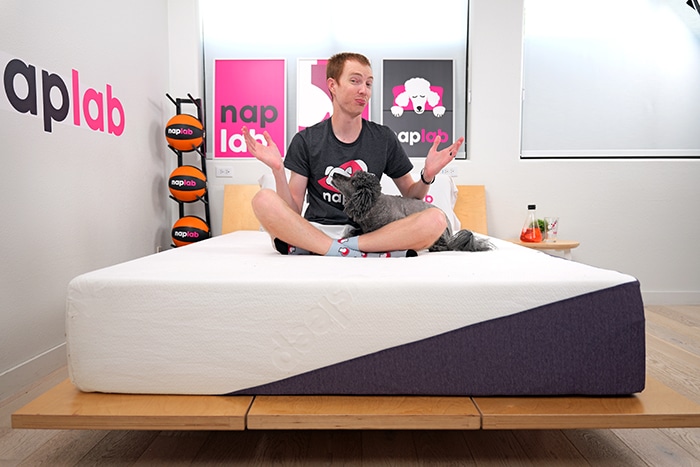
Disadvantages
The Luna has a number of categories that perform below-average including: Cooling, Edge Support, Sex, Pressure Relief, and Off-Gassing. The Polysleep also has a lower company score, with only a 100-night trial period and a 10-year warranty.
For reference, the average trial is 170 nights and 41% of the mattresses we test have lifetime warranties. The average of the other 59% is 13 years, 3 years longer than what Polysleep offers.
Cooling Test
The Polysleep Luna has good cooling. During our tests, I did not feel any significant level of heat retention around my body, but it was clear that the feel was a touch warmer than some other mattresses we’ve tested, especially those that contain springs.
Baseline Temp.
78.0° F
Max. Temp.
91.9° F
Ending Temp.
80.8° F
When we consider the design and materials, this is a fairly simple, all foam mattress. With respect to cooling benefits, we have a thin cover that’s helping improve breathability and a more airy top comfort foam. Beyond that, there really isn’t much going on that would help with cooling.
Max. Temp.
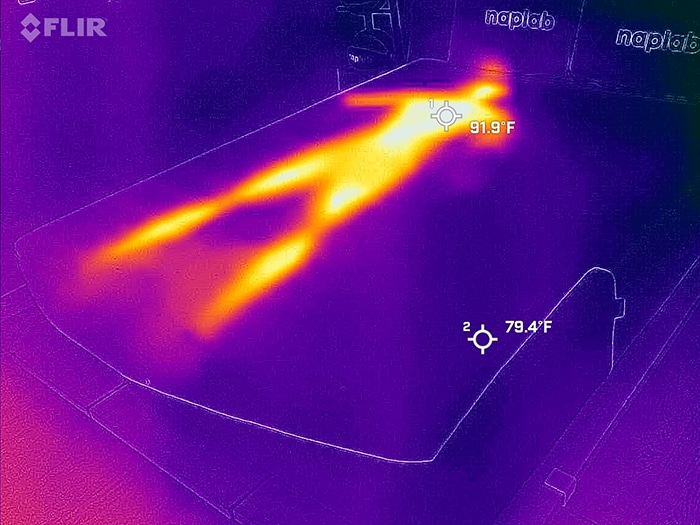
Ending Temp.

- Baseline Temperature – the temperature of the mattress before anyone lies on it
- Maximum Temperature (0 minute) – the temperature of the mattress after lying on it for 15 minutes
- Ending Temperature (5 minute) – the temperature of the mattress after being lied upon and having no one on it for 5 minutes
We don’t have any type of cooling cover, no thermoreactive fibers, no phase change materials, no coils for added airflow, no air cut channels into the foam, and no other notable cooling design or materials.
In our objective temperature tests, we measured a max surface level temperature of 91.9° F. This is 2.1° more than the average of 89.8° F, based on all of our tests to date.
After getting off the mattress, the temperature declined by 5.7 degrees from minutes 0 to 1, which is 1.0 degrees cooler than the average 0 to 1 minute decline of 4.7 degrees.
Heat Dissipation Over Time
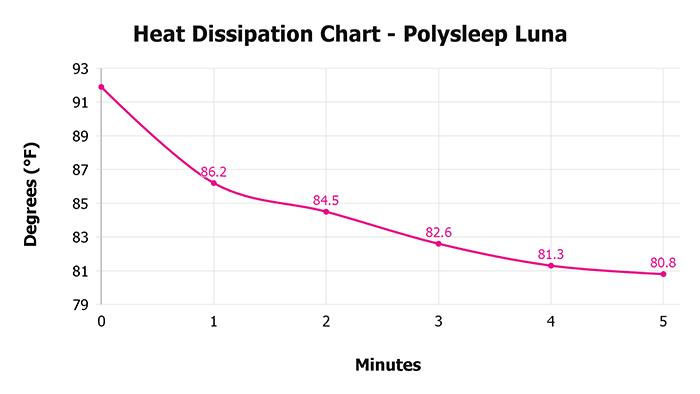
When we consider the combination of objective data, my subjective experiences, and an analysis of the materials, I’m confident in my view that cooling is good.
Sinkage Test
The Polysleep Luna has minimal sinkage. During our tests, we measured a pressure point sinkage depth of 1.88″. This is 0.30″ less sinkage than the average sinkage depth of 2.18″, based on all of our tests to date.
Sinkage Depth
1.88″
Sinkage Feel
Minimal
Body Contour
Slight
The level of sinkage is documented in the image below.
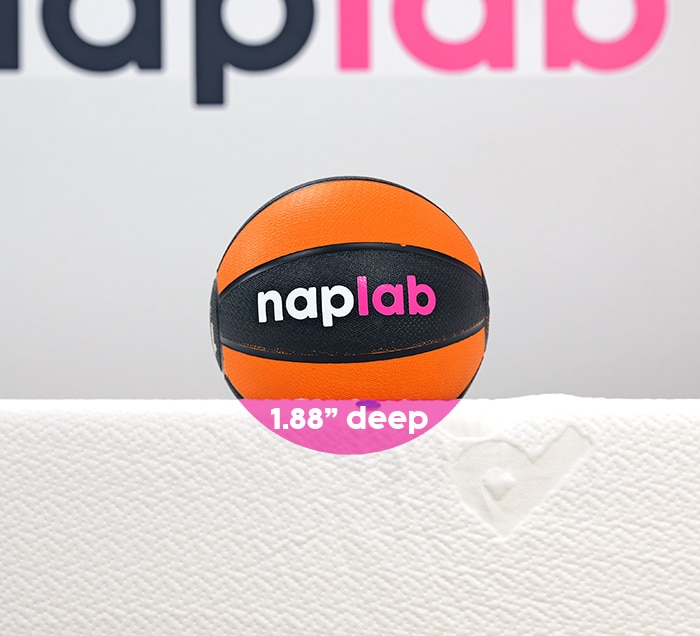
The mattress creates a slight level of body contouring hug and has more of a floating feel, where the body lies more “on” the mattress as opposed to sinking down “in” the mattress.
Heavier parts of the body do sink down further into the mattress, but lighter parts of the body, especially legs, arms, head, and feet are floating more on top of the mattress. That said, even these floated parts do get a slight level of hug, which helps with pressure relief.
This type of sinkage dynamic is neither good nor bad, but it is a more specific feel, one you’ll want to like to be comfortable on the Polysleep Luna.
Motion Transfer Test
The Polysleep Luna has a low level of motion transfer. During our tests, we measured a total acceleration range of 8.63 m/s². This is essentially the same as the average level of motion transfer, which is 8.65 m/s², based on all of our tests to date.
Accel. Range
8.63 m/s²
Motion Duration
0.76 seconds
The Luna’s motion transfer benefits due to the all-foam design. Foam does a great job at dispersing energy and reducing motion.
The Luna is equipped with a thicker-than-average 4.5” comfort layer and that layer in particular is doing much of the heavy lifting.
The level of motion transfer is also documented in the video below.
The thick foam layers help to keep bounce held to a below-average level, which further helps to manage motion transfer.
In our motion transfer chart, which visualizes our accelerometer data, we can see the highest motion peaks from 0 to 0.15 seconds. Motion drops significantly thereafter and by 0.76 seconds we’ve returned to near-zero levels of energy.
Motion Transfer Over Time

Overall, I’m pleased with motion transfer. Both the motion intensity and motion duration are kept to very reasonable levels, and as such, I think most sleepers will find motion transfer is sufficiently low.
Response Test
The Polysleep Luna has an extremely fast material response. In our mostly recovered test, we measured a recovery speed of 0.2 seconds, which is 0.22 seconds faster than the average of 0.42 seconds, based on all of our tests to date.
Mostly Recovered
0.2 sec.
Fully Recovered
0.3 sec.
In our fully recovered responsiveness test, we measured a recovery speed of 0.3 seconds, which is 0.68 seconds faster than the average of 0.98 seconds.
These responsiveness speeds are effectively instant and tied for 1st as the fastest material responsiveness we’ve tested to date.
The level of responsiveness is documented in the video below.
The use of a thin cover instead of a quilted cover, in combination with the all poly foam design and minimal sinkage depth, are all contributing to the fast response.
The fast response ensures the mattress is easy to move around and you’ll never feel stuck on the mattress.
Bounce Test
The Polysleep Luna has a low level of bounce. During our tests, we measured a total bounce height of 7.66″. This is 1.48″ less bounce than the average of 9.14″, based on all of our tests to date.
Max. Depth
5.10″
Max. Rebound
2.56″
Total Bounce
7.66″
The below-average bounce is the result of the all-foam design. Foam does a great job at absorbing and dispersing energy, which simply means there is less energy capable of rebounding a higher degree of bounce. As such, bounce is a double-edged sword.
Max. Sinkage Depth
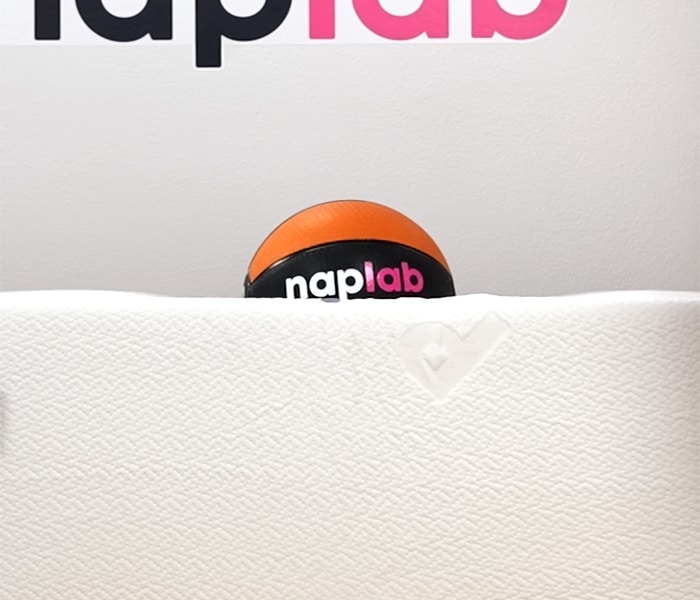
Max. Bounce Height
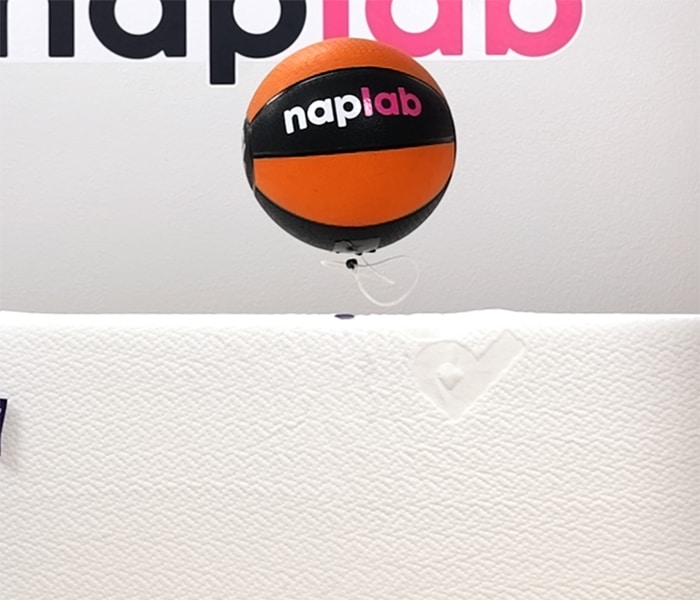
The level of bounce is also documented in the video below.
The lower bounce is a major reason why motion transfer is lower. But the low bounce also makes the mattress notably worse for sex. So there are absolutely pros and cons to consider here.
Edge Support Test
The Polysleep Luna has good sitting edge support and good lying edge support.
Max. Sinkage
4.50″
Lying Support
Good
Reinforced Edge
No
In our sitting edge support test, we measured a sitting sinkage compression of 4.50″. This is 0.50″ more sitting sinkage than the average of 4.00″, based on all of our tests to date.
The level of edge support while seated is documented in the images below.
Sitting, 140 lbs.
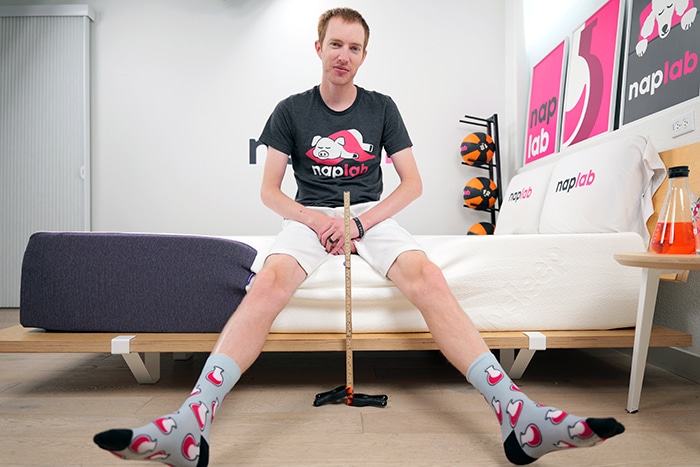
Sitting, 200 lbs.
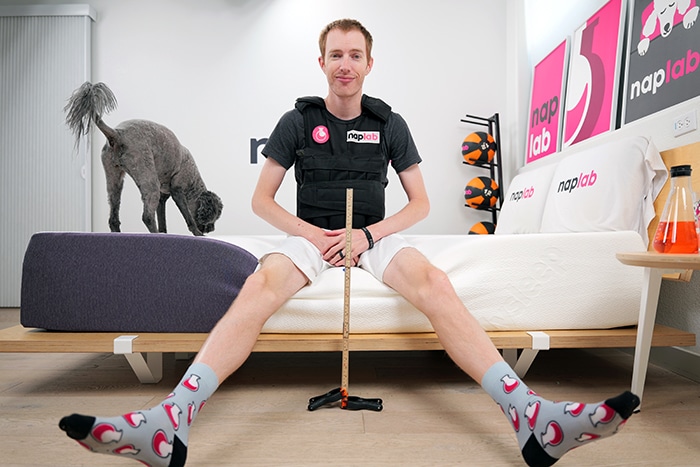
While lying directly on the edge of the mattress, I felt that the support was good in all sleeping positions. This mattress does not contain any type of reinforced edge support foam that would help improve edge support.
The level of edge support while lying is documented in the images below.
Lying on Edge, 140 lbs.
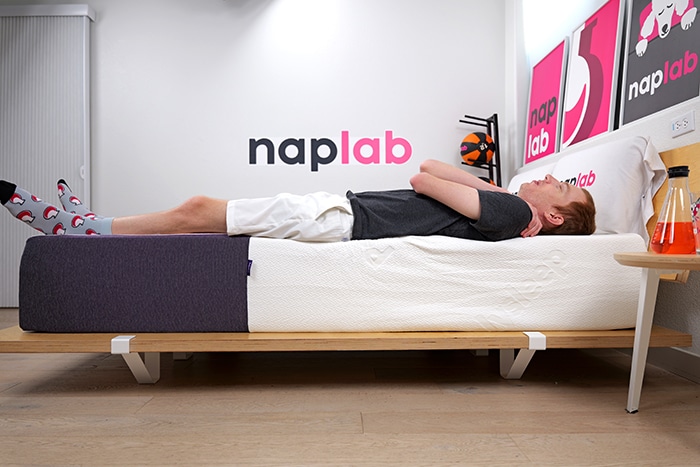
Lying on Edge, 200 lbs.
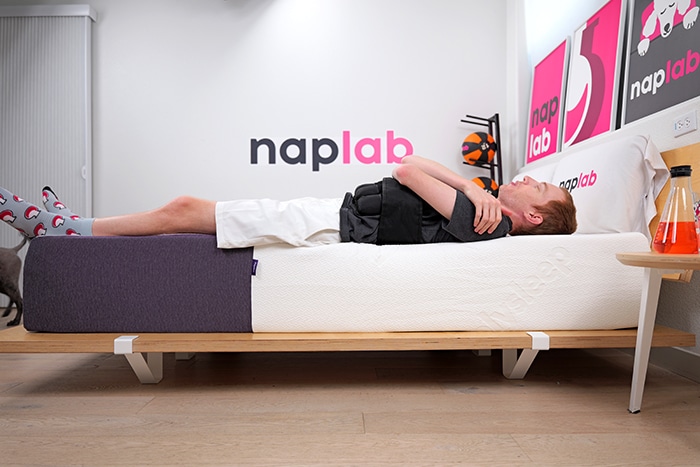
Ultimately, we have a fairly simple 12” all-foam design. While the minimal sinkage depth and medium-firm feel are helping to maintain a good level of support, it still wasn’t able to earn a better-than-average score.
When we compare this edge support performance to other mattresses, there is a clear difference. Polysleep’s Zephyr and Aura models both performed notably better in our testing.
Sex Test
The Polysleep Luna has fair sex performance. First up, let’s talk through the positive. Noise is minimal and both pressure relief and cooling are good. Mind you, they aren’t amazing and certainly have room for improvement, but for most couples, they should be sufficient.

Moving on, edge support also earned a good score with 4.50” of sitting sinkage. While this score is below average, it still maintains its shape, doesn’t collapse, and will help to extend the usable surface area of the mattress for couples.
| Sex Factor | Factor Weight | Score | Rating |
|---|---|---|---|
| Bounce | 65% | 7.3 | Moderate |
| Edge Support | 20% | 8.1 | Good |
| Noise | 5% | 10 | Minimal |
| Pressure Relief | 5% | 8.0 | Good |
| Cooling | 5% | 8.0 | Good |
Much like cooling and pressure relief, edge support performance is good, and yet, it’s clear it doesn’t rise to the excellent or outstanding level. Where the Polysleep Luna mattress is weakest for sex is bounce.
We have just 7.66” of total bounce height, which is well below the average bounce level. Less bounce makes a mattress more difficult, tiring, and strenuous for sex. As a result, the overall sex score is well below average.
Pressure Relief Test
The Polysleep Luna has a good level of pressure relief. During our tests, I felt no significant pressure points on my body, and yet, it’s clear the pressure relief performance isn’t as good as it could be.
In our testing of the Polysleep Zephyr and Polysleep Aura, we found both of those models to offer notably better pressure relief performance.
The mattress is equipped with 4.5″ of comfort material, which is 0.35″ more comfort material than the average comfort layer thickness of 4.15″, based on all of our tests to date.
Comfort Layer
4.5″
Support Layer
7.5″
While I’m pleased to see a thicker-than-average total comfort layer, the quality and feel difference between the two layers that make up that 4.5” comfort layer are notably different.
The topmost 2.5” thick layer looks and feels to be a higher quality and higher performance foam. There is both a visible difference and a difference in the way it feels on the body and in hand.
However, the 2.0” comfort layer in the core is less impressive. This foam layer is not immediately distinguishable from the support layer.
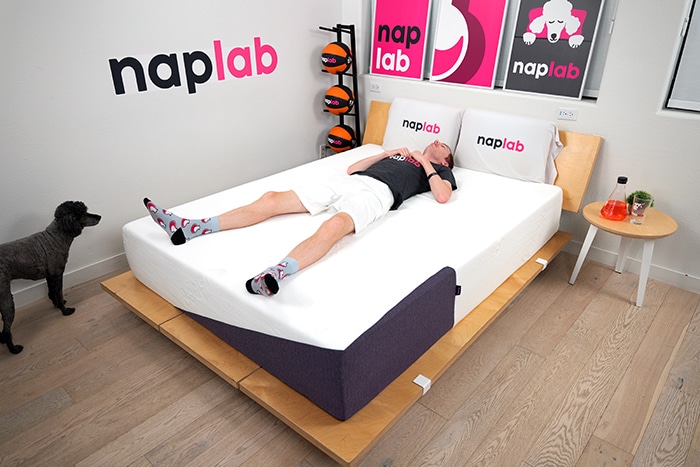
In my view, it looks to be closer to a support poly foam than it does a comfort poly foam. To be fair, it’s not identical to the support layer we see on the foundation of the mattress.
And yet, it’s clear it’s not the same type of higher-quality foam we see in the topmost 2.5” comfort layer.
In our pressure mapping tests, we measured a max PSI 1.06 on the stomach and 0.99 on my side. A 2.0 PSI is a high-pressure point and ideally, we want to see PSI well below 1.0.
Pressure Map – Side Sleepers
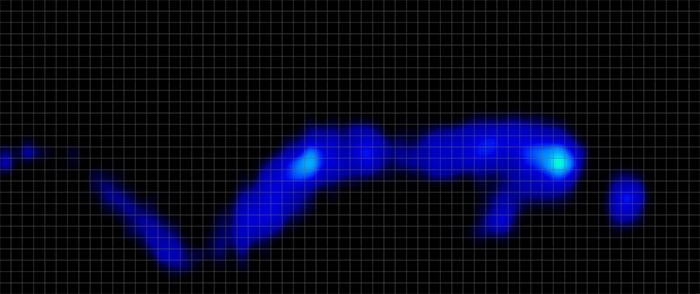
| Pressure Relief (PSI) | Average | Maximum |
|---|---|---|
| Side Sleepers | 0.14 | 1.06 |
Pressure Map – Back Sleepers
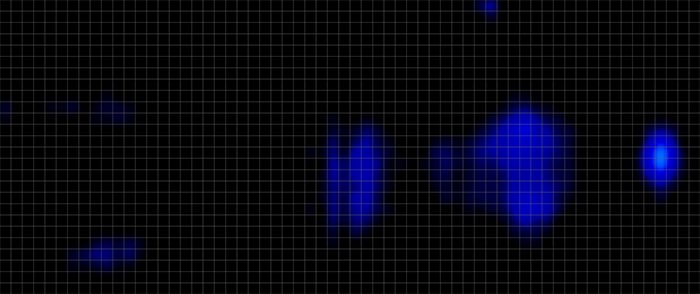
| Pressure Relief (PSI) | Average | Maximum |
|---|---|---|
| Back Sleepers | 0.08 | 0.50 |
Pressure Map – Stomach Sleepers
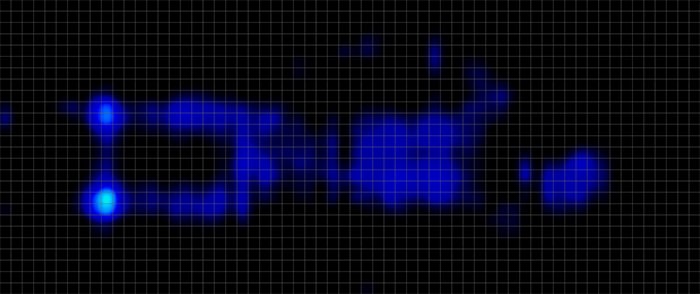
| Pressure Relief (PSI) | Average | Maximum |
|---|---|---|
| Stomach Sleepers | 0.09 | 0.99 |
All that to say, pressure relief isn’t bad by any stretch, but as with many other areas on the Luna, it’s clear there is room for improvement.
When I consider our objective pressure mapping tests, material thickness, material quality, and my subjective experience on the mattress, I’m confident most sleepers will find the pressure relief to be good.
Off-Gassing Test
The Polysleep Luna had a strong smell upon the initial unboxing. The mattress smelled for 11 days. This is 4.4 days longer than the average smell duration of 6.6 days.
Initial Smell Strength
Strong
Off-Gassing Period
11 days
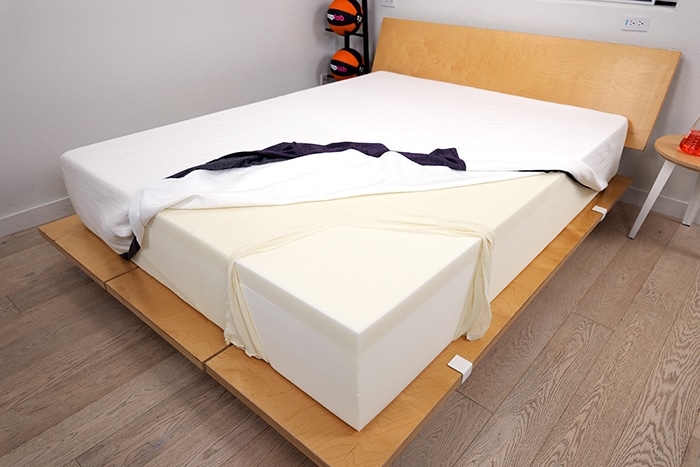
Company
Polysleep mattresses come with a 100-night trial period and a 10-year warranty. Shipping is free, but returns are $90 if the mattress ends up not working out.
| Company Factor | Factor Weight | Score | Data |
|---|---|---|---|
| Returns | 40% | 7.0 | $90 |
| Trial Period | 30% | 8.0 | 100 nights |
| Warranty | 20% | 8.0 | 10 years |
| Shipping | 10% | 10 | $0 |
| Country of Origin | 0% | Canada |
Comparing 101+ brands tested to date, the average trial period is 170 nights, 70 nights more than Polysleep offers.
The average warranty is 13 years, which is 3 years longer than this mattress, and that’s if we exclude the 41% of mattresses that offer lifetime warranties.
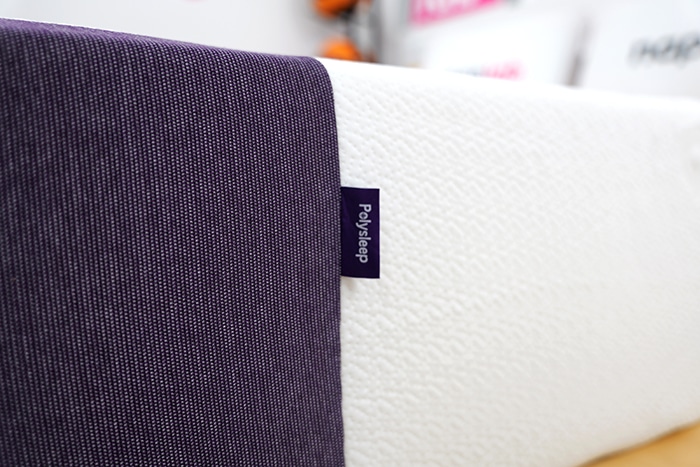
How firm is Polysleep Luna?
The Polysleep Luna is available in a single firmness, 6 out of 10, giving the mattress a medium-firm feel.

This firmness is generally suitable for a wide range of sleepers, with its balanced feel of comfort and support.
Support & Sleeping Positions
Support on the Polysleep Luna is excellent. During our tests, I felt well supported in all sleeping positions.
| Support Factor | Data |
|---|---|
| Comfort Layer | 4.5″ |
| Support Layer | 7.5″ |
| Firmness | Medium-Firm |
| Body Contour | Slight |
| Zoned Support | No |
| Reinforced Edge | No |
The mattress is equipped with a 7.5″ support layer. This is 0.43″ thinner than the average support layer thickness of 7.93″, based on all of our tests to date. In addition, the mattress has a medium-firm feel, which makes it a good choice for most sleepers and body types.
All that said, the sinkage dynamic on this mattress makes it a bit more polarizing. With only 1.88” of sinkage, it’s got a support dynamic that is more ideally suited to the needs of back and stomach sleepers.
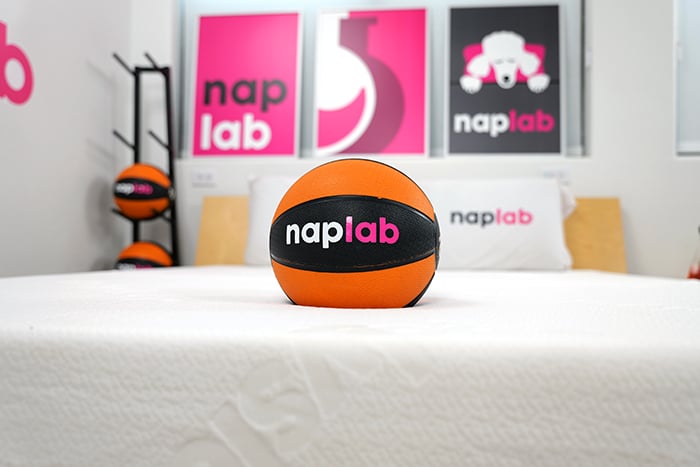
However, many side sleepers need more sinkage in order to create ideal support for the body while lying on the side. Mattresses with less sinkage can create too much pushback along the hips, which can be problematic for side sleepers. This effect will be more pronounced for lighter-weighted side sleepers.
Lastly, this mattress does not use any type of zoned support foam, meaning we have a universal level of support from head to foot.
Check out the table below to see the sleeper weights and sleeping positions that would be best suited for this mattress.
| Sleeper Weight | Stomach Sleeper | Side Sleeper | Back Sleeper |
|---|---|---|---|
| Under 150 lbs. | Yes | Maybe | Yes |
| 150-250 lbs. | Yes | Yes | Yes |
| 250-300 lbs. | Yes | Yes | Yes |
Based on all of my tests to date, an analysis of the materials, and my subjective experiences, I’m confident that most sleepers will find support on the Polysleep Luna is excellent.
Design
The Polysleep Luna is a 12″ foam mattress that comes in a single firmness option—Medium-Firm. It is designed as a budget-friendly foam mattress option with a balanced feel.
| Design Factor | Data |
|---|---|
| Type | Foam |
| Thickness | 12″ |
| Cover Type | Thin |
| Weight | 87 lbs. |
| Has Handles | No |
| Fiberglass-Free | Yes |
| Ships in a Box | Yes |

Materials
The Polysleep Luna is 12″ thick with a simple design that contains poly foam and support foam. From top to bottom, here is a full list of the materials used in this mattress:
| Layer Type | Thickness | Layer Specs |
|---|---|---|
| Poly Foam | 2.5″ | 3.0 PCF |
| Poly Foam | 2.0″ | 1.7-1.8 PCF |
| Support Foam | 7.5″ | 1.7-1.8 PCF |
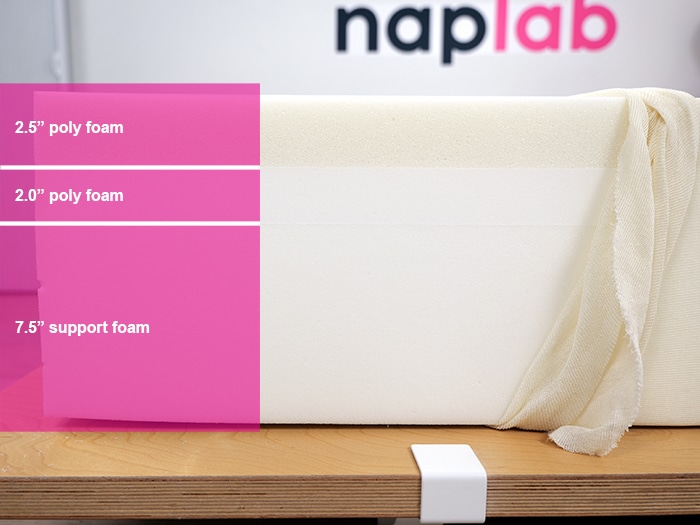
The Law Tag outlines the full breakdown of materials included in this mattress.
- Materials
- 100% polyurethane, 2 layers of foam
- Cover
- 100% polyester
- Made for Polysleep Inc. 515 Rue De La Savane suite 402, Montreal, QC, Canada, H4P 1V1
- Date of delivery:
- Finished size: 60 in x 80 in x 12 in
- Net weight of filling mat: 74.4 lbs.
- Manufactured by: Domfoam inc. 8785 Boul Langelier, Saint-Leonard, QC, Canada, H1P 2C9
- Date of manufacture:
- Importer/U.S. Records Location Miliken Analytical Services Magnolia Plant-Summit Dock 157 Miliken Rd. Blacksburg, SC 29702
- Model: CTS424141
The Cover
The Polysleep Luna has a thin cover that is soft and stretchy. It is also removable for spot cleaning or machine washing. The manufacturer recommends washing on delicate with cold water and air drying.

The Comfort Layer
The comfort layer is 4.5″ thick and made of two layers of poly foam. The top is a 2.5″ poly foam followed by a 2.0″ transitional poly foam.
While Polysleep calls the top layer memory foam, that’s not exactly the feel I experienced when I tested this mattress. Memory foam has a more dramatic body contouring hug and often has a slower material responsiveness (IE, viscoelastic properties). The Luna does not have those more expected memory foam properties.

These comfort layers feel and act like poly foam. It has a faster response time and the contour feels more generalized compared to the exacting contour of memory foam.
As I mentioned above, this is neither good nor bad, but certainly something to consider if you’re looking for a more traditional memory foam mattress.
The Support Layer
The support layer is 7.5″ thick and made of a single layer of support foam. This support foam is firmer and acts as the foundational base for the mattress.
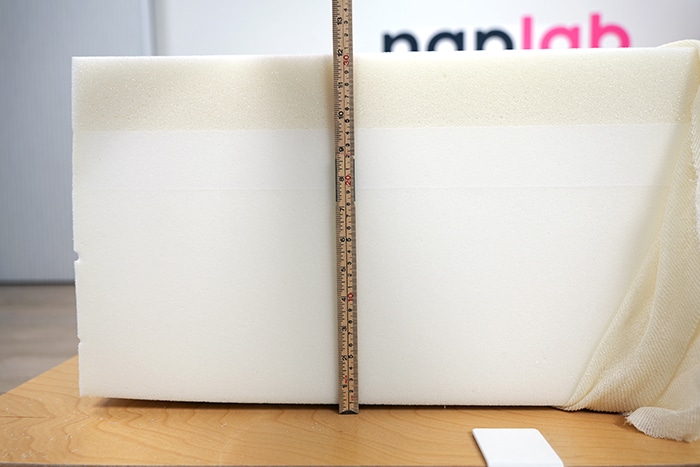
Product Evolution
The Polysleep Luna launched in early 2025. Since launching there have been no major changes made to the design or materials.
We will update this section if / when changes are made to the design.
Other Mattresses to Consider
Not sure if the Polysleep Luna is the right pick for you? Check out these three other top-rated Canadian foam mattresses for high-performing alternatives you may want to consider.
For Performance
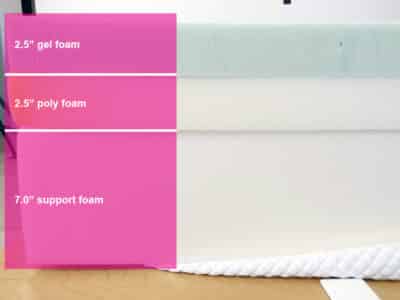
Douglas Summit
Higher Quality Option
The Douglas Summit is a 12″ foam mattress with a similar feel to the Luna. It has minimal sinkage, low bounce, and a medium-firm feel (6). The price is higher for the Summit, $1,299 for a queen, but you’re also getting a higher quality mattress. In our tests, the Summit outperforms the Luna in 6 out of 8 performance tests.
For Better Sex
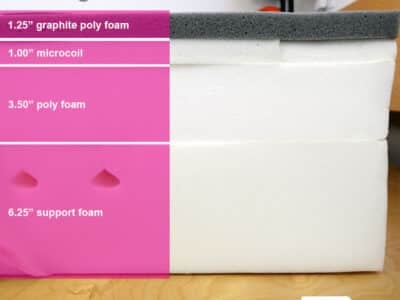
Simba Hybrid 2500
For High Bounce
The Simba Hybrid 2500 is a 12″ foam mattress with minimal sinkage, high bounce, and a medium-firm feel (6). Like the Luna, the Simba has a poly foam comfort layer and a support foam base. But one difference is the high level of bounce on the Simba compared to Luna, which gives the mattress better sex performance. Simba is also significantly more expensive—C$2,199 for a queen mattress.
For Firmer Feel

Endy
More Sinkage + Bounce
The Endy is a 10″ foam mattress with very deep sinkage and very high bounce. It has a firmness that is slightly firmer than the Luna (7 out of 10). Overall, this is very different mattress, despite still having a poly foam comfort layer. The Endy is also cheaper, C$895 for a queen mattress, yet has a higher overall performance.
Frequently Asked Questions
Still have questions? Check out some of the top FAQs on the Polysleep Luna mattress below and get the answers you’re looking for.
Here are the current prices, with any sales or promotions reflected below:
Twin: $732
Twin XL: $767
Full: $893
Queen: $963
King: $1,117
Cal. King: $1,117
*Note: Sales prices are subject to change without notice or warning.


